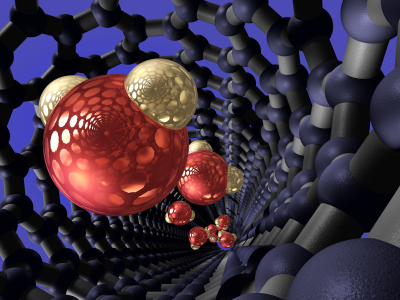Advances in nanotechnology enable targeted drug delivery
March 31, 2011
Three research groups announced nanotechnology-based targeted drug-delivery systems Wednesday.
Researchers at Cedars-Sinai’s Maxine Dunitz Neurosurgical Institute have used a highly targeted approach to deliver multiple drugs chemically bonded to a transport vehicle. The objective is to bypass healthy cells, accumulate inside tumor cells, and attack molecular targets that enable cancer cells to grow and spread.
The drug transport is in an emerging class called nanobiopolymeric conjugates, or nanoconjugates, the latest evolution of molecular drugs designed to enter cells and alter defined targets within them. Injected into mice with implanted human breast cancer cells, the drugs accumulated in the cancer cells and worked together to significantly reduce tumor growth.
The new drug transport carries multiple molecular components, each with a distinct role. Their research targeted HER2-positive breast cancer. The key components include Herceptin to target the existing HER2 protein, another molecule to attack a genetic mechanism responsible for the production of new protein, and a molecule to open tumor blood vessels and deliver the drugs into the cancer cells for release.
Ref.: JY Ljubimova et al., “Polymalic Acid–Based Nanobiopolymer Provides Efficient Systemic Breast Cancer Treatment by Inhibiting both HER2/neu Receptor Synthesis and Activity,” Cancer Research, February 15, 2011.
Scientists at the University of Maryland in College Park have created prototype bacteria that serve as mobile pharmaceutical factories, producing disease-fighting substances and delivering potentially life-saving drug cargo to diseased areas of the body. Inside the bacteria is a gene segment that acts as nanofactory. It uses the bacteria’s natural cellular machinery to make drugs that can fight bacterial infections, viruses, and cancer. The bacterial dirigibles can send out a strong signal to which disease-fighting cells of the body can respond.
The research was presented at a meeting of the American Chemical Society and released by the ACS on March 29.
To identify cells to target, researchers at Kansas State University have developed a nanotechnology-based biosensor that may allow early detection of both cancer cells and pathogens, leading to increased food safety and reduced health risks.
The team used carbon nanofibers to form an array of tiny electrodes that is smaller than bacteria and viruses. When these microbial particles are captured at the electrode surface, an electric signal can be detected. Their goal is to integrate this technology into a hand-held electronic device for pathogen detection.
The work was accepted for publication in the journal Electrophoresis.
